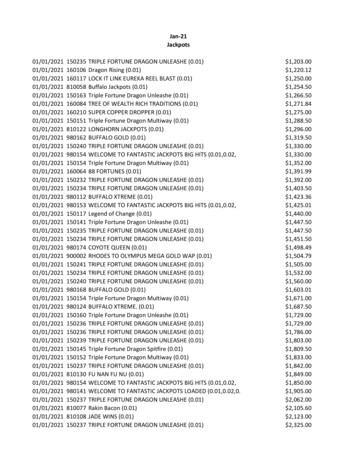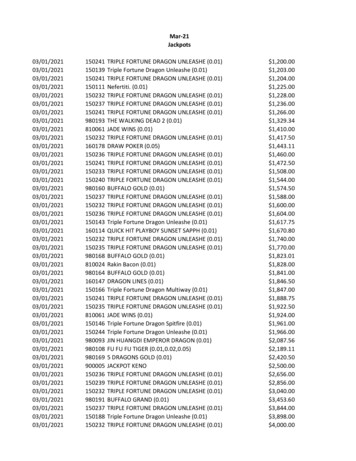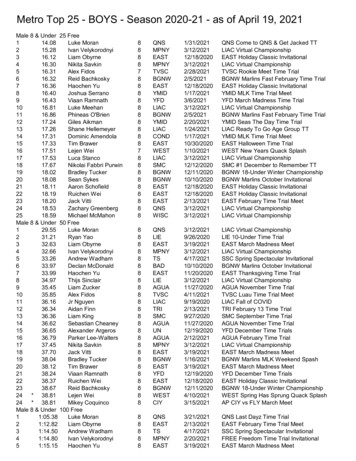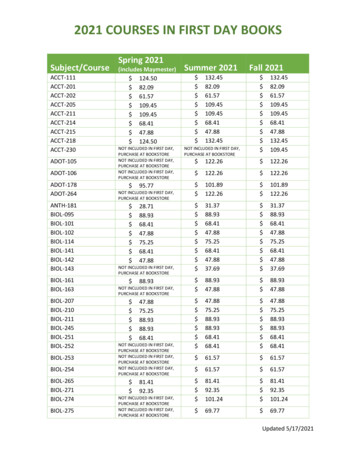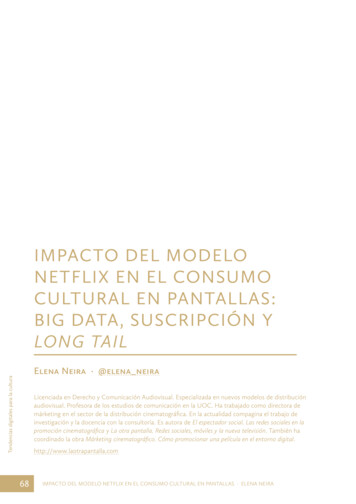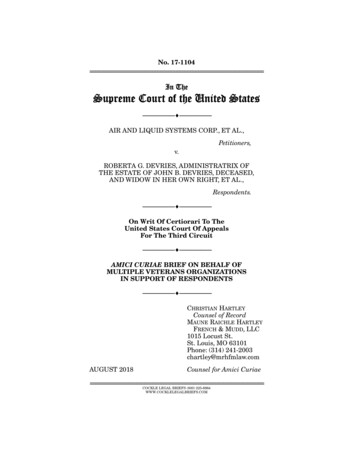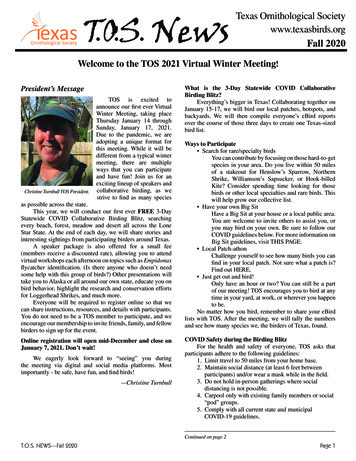
Transcription
Texas Ornithological Societywww.texasbirds.orgFall 2020Welcome to the TOS 2021 Virtual Winter Meeting!President’s MessageChristine Turnbull TOS President.TOS is excited toannounce our first ever VirtualWinter Meeting, taking placeThursday January 14 throughSunday, January 17, 2021.Due to the pandemic, we areadopting a unique format forthis meeting. While it will bedifferent from a typical wintermeeting, there are multipleways that you can participateand have fun! Join us for anexciting lineup of speakers andcollaborative birding, as westrive to find as many speciesas possible across the state.This year, we will conduct our first ever FREE 3-DayStatewide COVID Collaborative Birding Blitz, searchingevery beach, forest, meadow and desert all across the LoneStar State. At the end of each day, we will share stories andinteresting sightings from participating birders around Texas.A speaker package is also offered for a small fee(members receive a discounted rate), allowing you to attendvirtual workshops each afternoon on topics such as Empidonaxflycatcher identification. (Is there anyone who doesn’t needsome help with this group of birds?) Other presentations willtake you to Alaska or all around our own state, educate you onbird behavior, highlight the research and conservation effortsfor Loggerhead Shrikes, and much more.Everyone will be required to register online so that wecan share instructions, resources, and details with participants.You do not need to be a TOS member to participate, and weencourage our membership to invite friends, family, and fellowbirders to sign up for the event.Online registration will open mid-December and close onJanuary 7, 2021. Don’t wait!We eagerly look forward to “seeing” you duringthe meeting via digital and social media platforms. Mostimportantly - be safe, have fun, and find birds!—Christine TurnbullWhat is the 3-Day Statewide COVID CollaborativeBirding Blitz?Everything’s bigger in Texas! Collaborating together onJanuary 15-17, we will bird our local patches, hotspots, andbackyards. We will then compile everyone’s eBird reportsover the course of those three days to create one Texas-sizedbird list.Ways to Participate Search for rare/specialty birdsYou can contribute by focusing on those hard-to-getspecies in your area. Do you live within 50 milesof a stakeout for Henslow’s Sparrow, NorthernShrike, Williamson’s Sapsucker, or Hook-billedKite? Consider spending time looking for thosebirds or other local specialties and rare birds. Thiswill help grow our collective list. Have your own Big SitHave a Big Sit at your house or a local public area.You are welcome to invite others to assist you, oryou may bird on your own. Be sure to follow ourCOVID guidelines below. For more information onBig Sit guidelines, visit THIS PAGE. Local Patch-athonChallenge yourself to see how many birds you canfind in your local patch. Not sure what a patch is?Find out HERE. Just get out and bird!Only have an hour or two? You can still be a partof our meeting! TOS encourages you to bird at anytime in your yard, at work, or wherever you happento be.No matter how you bird, remember to share your eBirdlists with TOS. After the meeting, we will tally the numbersand see how many species we, the birders of Texas, found.COVID Safety during the Birding BlitzFor the health and safety of everyone, TOS asks thatparticipants adhere to the following guidelines:1. Limit travel to 50 miles from your home base.2. Maintain social distance (at least 6 feet betweenparticipants) and/or wear a mask while in the field.3. Do not hold in-person gatherings where socialdistancing is not possible.4. Carpool only with existing family members or social“pod” groups.5. Comply with all current state and municipalCOVID-19 guidelines.Continued on page 2T.O.S. NEWS—Fall 2020Page 1
Continued from page 1Meeting AgendaAll meeting events will be held virtually via Zoom.Birding will take place across Texas.Thursday, January 143:30-5:30 PMTOS Board Meeting6:00-6:30 PM“Check-in” on Zoom6:30-7:00 PM Welcome/Introductions/Announcements via Zoom (Lots ofuseful information is given during thistime, so please attend.)7:00-8:00 PM Speakers: TOS Regional Directors –Favorite Birding Locations in TheirRegionsFriday, January 15All Day Birding – 3-Day Statewide COVIDCollaborative Birding Blitz3:30-4:30 PM Speaker: Cin-Ty Lee – EmpidonaxIdentification4:45-5:45 PM Speaker: Dr. Tania Homayon –Texas Nature Trackers: DiscoveringPopulations & Documenting Changefor Conservation6:00-7:00 PM Announcements/Birding Reports/Social Hour7:00-8:00 PM Speaker: Romey Swanson – AudubonTexas Bird Conservation in TexasSaturday, January 16All Day Birding – 3-Day Statewide COVIDCollaborative Birding Blitz9:00 - 11:00 AMPhotography Class with Lee Hoy3:30-4:30 PM Speaker: Dr Byron Stone – BirdingAlaska with TOS4:45-5:45 PM Speaker: Shelia Hargis – MagicalMigrations6:00-7:00 PM Announcements/Birding Reports/Social Hour7:00-8:00 PM Speaker: Jennifer Ackerman – TheBird WaySunday, January 17All Day Birding – 3-Day Statewide COVIDCollaborative Birding Blitz3:30-4:30 PM Speaker: Kent Rylander – BirdBehavior4:45-5:45 PM Speaker: Sue Heath with JenniferWilson – Migrant and ResidentLoggerhead Shrike HabitatAffiliations in Texas6:00-7:00 PM Announcements/Birding Reports/Social Hour7:00-8:00 PM Speaker: Nathan Pieplow – Listen toHer SingPage 2Registration InformationAn email containing the link to registration on the TexasOrnithological Society’s website, www.texasbirds.org, will besent in mid-December, so be sure your email address is up todate in your TOS account. Please also share the link and thisinformation through various social media outlets with nonTOS members and any local birding friends, clubs, and groupswe may miss, as ALL are welcome to join this meeting.If you do not have access to the internet, you may callJudy Kestner at 361-387-7329 or Frances Cerbins at 512372-9039 for assistance with registration. If you don’t get ananswer, leave a message and Judy or Frances will call youback when they are available.Registration will close on January 7, 2021.Event Prices3-Day COVID Collaborative Birding Blitz:FREESpeaker Package, including access to TEN excitingpresentations: 25 for TOS members 35 for Non-TOS members 60 for Non-TOS members (includes a one-yearmembership)Free registration for students2 Hour Saturday Virtual Photography Class: 10 for TOS members 15 for Non-TOS membersPhotography ClassSaturday, 9:00 AM – 11:00 AMCost: 10 for members/ 15 for non-membersDescription: Wildlife/Bird photography is unlike anyother style of photography in that our ability to understand,find, and know our subjects is key to our success. What isit that helps separate great wildlife/bird photographers fromgood ones? What skills, habits, tips, and knowledge do youneed to take your wildlife/bird photography to the next level?When do technical and creative exposure come together toproduce brilliant images? Join us for all this and more!Bio: Lee Hoy isthe owner/operator ofBig Bend Birding &PhotoTours and a freelancephotographer. An awardwinningphotographer,his images have beenpublished in Texas Parks& Wildlife Magazine,Texas Highways, BirdWatcher’sDigest,& Lee HoyNANPA’s Expression. Leehas taught myriad coursesincluding beginning birding classes, photography classes, andLightroom classes, serving as an instructor for Travis AudubonSociety, Williamson Audubon Group, many Master Naturalistclasses, and the Texas Ornithological Society.T.O.S. NEWS—Fall 2020
Meeting PresentationsThursday Evening7:00 PMTitle: Favorite Birding Spots of TOS Regional DirectorsPresenters: TOS Regional DirectorsDescription: TOS has divided Texas into eightgeographic regions. Each region has a TOS Director whorepresents that region in Board meetings. Join us for thisopportunity to meet the directors and learn about their favoritebirding locations. This will give you some great ideas forfuture birding adventures once COVID is behind us and weare free to go birding anywhere we want. Visit the About TOS,Board of Directors section of our website, http://texasbirds.org/aboutTOS.php, to see maps of each region including thecounties included in each.Your regional directors are: Region 1 – John Berner (Acting Director), Region 2 – Gailon Brehm, Region 3 – Laura Wilson,Region 4 – D. D. Currie, Region 5 – Christine Turnbull, Region 6 – Daniel Hodges, Region 7 – Raul Delgado, and Region 8 –Kendra Kocab.Friday Afternoon3:30 PMTitle: Making Empidonax Identification AccessiblePresenter: Cin-Ty LeeDescription: Empidonax flycatchers are among themost challenging bird species to identify because there areno single field marks that can be relied on. Instead, empididentification relies on a combination of soft field marks, suchas structure and relative color contrasts. All of these featuresare subtle, making it difficult to even teach the basics of empididentification. In this talk, Cin-Ty will show you how to lookat an empid so that you are better prepared for entering thisnotorious ID challenge.T.O.S. NEWS—Fall 2020Bio: Cin-Ty Leehas been birding since hewas ten years old. He’slived in Houston for 18years, where he teachesgeology and ornithologyat Rice University. Hehas written numerousarticles on challengingbird identifications, suchas pewees, dowitchers,female orioles, pipits and Cin-Ty Leeloons. He has recentlybegun a dedicated effort to track nocturnal migrants overHouston with passive recording.Page 3
4:45 PMTitle: Texas Nature Trackers: Discovering Populations &Documenting Change for ConservationPresenter: Tania HomayonDescription: Texas Parks & Wildlife’s Texas NatureTrackers (TNT), part of the Wildlife Diversity Program, tracksthe status of wild populations of plants and animals throughoutthe state. This presentation will introduce the Texas NatureTrackers program and how it uses iNaturalist to support theWildlife Diversity Program’s conservation work on Speciesof Greatest Conservation Need across the state. We’ll discusssome TNT projects and data needs and how this frameworkenables iNaturalist users and bioblitz participants to be activepartners in conservation.Bio:Dr.TaniaHomayoun is a TexasNature Tracker Biologistwith Texas Parks andWildlife. Through TexasNature Trackers, sheengages naturalists ofall interests and abilitylevels in collecting citizenscienceandcrowdsourced data on Texas’unique flora and fauna Tania Homayounwith a particular focuson species of greatest conservation need. Previously, Taniaworked for Audubon Texas, with the Dogwood CanyonAudubon Center and later the Conservation Science Teamas its Urban Conservation Program Manager where sheworked to develop and deliver conservation plans, educationalprograms/trainings,and activities supporting biodiversity andsustainable communities.Tania holds a BS in Ecology/Evolution/ConservationBiology and a BA in Anthropology from the University ofTexas at Austin and a PhD in Conservation Biology from theUniversity of Minnesota, where she studied the impacts ofurbanization on landbird communities. She is an avid birderand always has room for one more native plant in her patiogarden.Page 4Friday Evening7:00 PMTitle: The Wonderful Wild of Texas: BirdsPresenter: Romey Swanson, Director of ConservationStrategy, Audubon TexasDescription: This talk will cover the many characteristicsthat make Texas so biologically rich - through a bird’s eyeview. We’ll explore Texas’ bird diversity while detailing theseemingly disparate eco-regions that support them. We’lldetail the many conservation challenges that exist throughoutTexas and how these challenges shape an uncertain future.We’ll also explore conservation successes and the role ofprivate landowners in Texas conservation. We’ll review thescience that drives Audubon Texas’ strategic conservationplanning and how we all have a stake in the health of birdpopulations. From Burrowing Owls on the shortgrass prairies,Black-capped Vireos along arid river basins, the breedingwarbler diversity of East Texas forests, to the nesting hauntsof coastal waterbirds - there should be something for all birdenthusiasts.Bio: Romey SwansonworksforAudubonTexas as the Director ofConservation Strategy. Inthis role, Romey workswith state, national, andinternationalpartnersto identify and advanceimportantconservationstrategies to benefit birds,wildlife, and people.Romey is a Certified Romey SwansonWildlife Biologist andPresident Elect of the Texas Chapter of The Wildlife Society- Texas’ largest professional society of wildlife managers.Additionally, Romey is an active leader within the TexasLand Trust Community serving on several organizations’boards and committees. He received a Master’s Degree fromTexas State University studying the wildlife of Central Texas.Romey lives in Austin and enjoys spending time with hisfamily hunting, camping, and studying nature – much like hisfavorite naturalist Teddy Roosevelt.Saturday Afternoon3:30 PMTitle: Birding Alaska with TOSPresenter: Byron StoneDescription: Byron “Doc” Stone’s talk tonight willoutline the exciting birding potential that Alaska offers in earlysummer. He has co-led the TOS “Grand Alaska Adventure”birding trip twice, first with Jim Hailey in June 2017 and againin June 2019 with Randy Pinkston. Byron and Randy plan toco-lead the trip again in June 2021.Bio: Byron “Doc” Stone is an Austin physician andnaturalist and a self-described lifelong “nature freak.” He grewup in central Texas and has been an avid birder for over fourdecades. Byron has traveled widely in Texas and other statesT.O.S. NEWS—Fall 2020
Byron Stoneto observe birds and wildlife andteaches classes for Travis AudubonSociety on sparrows and raptors.He was the creative force behindthe development of SparrowFest,a winter celebration of sparrowabundance and diversity at BalconesCanyonlands NWR in central Texas.Doc formerly served on theTexas Bird Records Committee,is a Past-President of the TexasOrnithological Society, and has anabiding interest in conservation andecology.4:45 PMTitle: Magical Migrations: Birds on the MovePresenter: Shelia HargisDescription: Most of us are very familiar with springmigration. This presentation will focus on a couple ofother magical migrations, migrations that tend to be reallyspectacular in the late summer and fall. You will learn aboutthe migrations of Chimney Swifts and Purple Martins, howyou can observe these birds on their way south, how you canhelp these birds as they undergo their demanding travels, andhow you can participate in citizen science by participatingin Swift Night Out. The migrations of these species are asspectacular as spring migration, just in different ways. Join usfor this presentation so that you’ll be prepared to experiencethem for yourself!Bio: Shelia has beenbirding for nearly 25 yearsand is totally obsessed withbirds! She spends mostof her free time birdingor thinking about birds.Shelia gives presentationson a variety of bird topics,surveys birds for the Cityof Austin and the NorthAmerican Breeding BirdSurvey as well as private Shelia Hargislandowners, and regularlyleads birding field trips. She is Past-President of both TravisAudubon and Texas Ornithological Society.Saturday Evening7:00 PMTitle: The Bird WayT.O.S. NEWS—Fall 2020Presenter: Jennifer AckermanDescription: A multimediapresentation on The Bird Way, this talkexplores a kaleidoscope of fascinatingbehaviors in the bird world throughthe lens of five arenas of daily activity:communication, work, play, love,and parenting. It tells stories aboutsome of the extraordinary ways thatbirds do these things and the secret,sophisticated intelligence underlyingtheir behavior. The talk also explores the new discoveriesthat are overturning many of our old, conventional ideas abouthow birds live their lives, describes how science is makingsome of these astonishing discoveries, and shows the moststunning examples from each section of the book. The talkranges from the tropical rainforests of eastern Australia andthe remote woodlands of northern Japan, to the rolling hills oflower Austria and the islands of Alaska’s Kachemak Bay, andincludes audio, video, and spectacular photos by professionalphotographers.Bio:JenniferAckerman is a New YorkTimes bestselling authorwho has been writingabout science, nature,and human biology formore than three decades.She is the author of eightbooks. Her most recentbook, The Bird Way: ANew Look at How BirdsTalk, Work, Play, Parent, Jennifer Ackermanand Think, was published in spring of 202 0 by Penguin Pressand is described by reviewers as “splendid and spellbinding,”“exhilarating”, and “an enthralling study of the avian world.”The book was selected as an Editor’s Choice by the NewYork Times and a “best summer science book of 2020” byNPR’s Science Friday and will be published in more than tenlanguages. Her previous book, the bestselling The Genius ofBirds (Penguin Press, 2016; paperback, 2017) is described byScientific American as “a lyrical testimony to the wondersof avian intelligence,” and by The Wall Street Journal as “agloriously provocative and highly entertaining book.” TheGenius of Birds was named one of the 10 best nonfictionbooks of 2016 by The Wall Street Journal, a Best ScienceBook of 2016 by National Public Radio’s “Science Friday”,and Nature Book of the Year by the London Sunday Times. Itis published in more than 20 languages.The revised and reissued edition of Jennifer’s first book,about the natural life of the mid-Atlantic coast, was publishedby Penguin Press in 2019 under the title Birds by the Shore.Her previous books include Sex Sleep Eat Drink Dream: ADay in the Life of Your Body (Houghton Mifflin), Ah-Choo:The Uncommon Life of Your Common Cold (Twelve), andChance in the House of Fate: A Natural History of Heredity(Houghton Mifflin).Jennifer has contributed articlesand essays to National Geographic, The New York TimesMagazine, Scientific American, The Wall Street Journal, andmany other publications. She is the recipient of a LiteratureFellowship in Nonfiction from the National Endowment forthe Arts, a Bunting Institute fellowship from Radcliffe College,and a grant from the Alfred P. Sloan Foundation.Page 5
Sunday Afternoon3:30 PMTitle: Understanding Bird BehaviorPresenter: Kent RylanderDescription:Somebirdbehaviors seem obvious, such as abird fleeing a hawk, but some aremore puzzling. It’s not immediatelyclear, for example, why a gull lifts itshead to the sky when displaying andappears to use the same movementswhen drinking. Is there a connectionbetween these two behaviors?A number of brilliant studentsof animal behavior tackled questionssuch as this one during the last century. Among them wereKonrad Lorenz and Niko Tinbergen, who were awarded theNobel Prize for their work in animal behavior.In this TOS virtual presentation, I’ll explain some ofthe behaviors we regularly see at our bird feeders and on ourbird walks, in particular some common innate and learnedbehaviors.Bio: Kent grew upon a farm near Denton,Texas, where he and hisbrother Rod were birdersthroughout their teenageyears. Kent majored inbiology at UNT and afterserving in the U.S. Armyhe completed his doctoratein zoology in 1965 atTulane University in NewKent RylanderOrleans. The same yearhe joined the faculty atTexas Tech University, where he taught ornithology, animalbehavior, comparative anatomy, and neuroanatomy. Althoughhe retired in 2004, he continued teaching a summer coursein ornithology at Texas Tech’s Junction campus until 2015.During his career at Tech he made a number of research trips toColombia, Ecuador, and Peru, and to Austria, where he studiedthe behavior of geese. In 2002, he published The Behaviorof Texas Birds (University of Texas Press). He currently liveswith his wife, Laura Ronstadt, in Fredericksburg.4:45 PMTitle: Migrant and Resident Loggerhead Shrike HabitatAffiliations in TexasPresenter: Sue Heath with Jennifer WildonDescription: The Gulf Coast Bird Observatory (GCBO)and the Texas Midcoast National Wildlife Refuge Complexhave initiated a project on the upper Texas coast to determinethe difference in habitat usage by resident and migrantLoggerhead Shrikes.Although Loggerhead Shrikes are still common inTexas, this species has undergone a 79% decline over the lifeof the Breeding Bird Survey. Some studies have indicatedthat constraints associated with winter habitat are limitingthe migratory populations of this species. The Texas Gulfcoastal prairie contains both migrant and resident shrikesPage 6from November through February, but we do not know howmigratory and resident populations coexist during this timeperiod.Our ongoing project seeks to determine if there aredifferences in habitat affiliations for migrant and residentshrikes during winter in Texas.Bio: Susan Heath is anative Texan who returnedto the state in 2007 afterbeing transplanted toVirginia for 24 years. Afterserving in the U.S. Navyfor four years and workingas a computer securityanalyst in the WashingtonD.C. area for 12 years, shedecided to return to schoolto focus on employment Susan Heaththat was more personallymeaningful. Sue received a Master’s in Biology from GeorgeMason University for her work on wintering waterfowl on theNorthern Virginia Piedmont in 2003 and a Ph.D from the sameinstitution in the spring of 2008. Her dissertation involved theeffects of pesticides on birds that nest in agriculture in thenorth central states.At Gulf Coast Bird Observatory (GCBO), she is in chargeof conservation research including research projects focusedon American Oystercatcher stewardship, beach nesting birds,non-breeding shorebirds, Black Skimmer monitoring, Motustower network, Eastern Willet migration, bird use of intertidalreef, Loggerhead Shrike conservation, and the Smith PointHawk Watch.Sunday Evening7:00 PMTitle: Listen to Her SingPresenter: Nathan PieplowDescription: Only male birdssing, right? Wrong! In fact, thiswidespread notion has a lot more to dowith human cultural and geographicbiases than it has to do with nature. Inthis talk, NathanPieplow explores the oftenoverlooked songs of female birds. Youwill hear the pair duets of meadowlarksand blackbirds, the musical songs offemale cardinals and orioles, and thedistinctive song of the female CanyonWren, among others. In which species do females actuallysing more often than males? How do you know when you’relistening to a female Blue Jay? And where did we even getthis crazy idea that only male birds sing? Answers to thesequestions and more in this presentation.Bio: Growing up in South Dakota, Nathan Pieplow gotstarted identifying bird songs by studying the classic “BirdingBy Ear” field guides in the Peterson series. It wasn’t until 2003,when he faced the frustrations of studying sounds for his firsttrips to Mexico and Costa Rica, that he became dedicated tofinding new and better ways to learn, describe, and catalogT.O.S. NEWS—Fall 2020
bird sounds. Along theway he became a soundrecordist and an amateurethologist (a student ofanimal behavior).Nathan says, “I’m notone of those superhumanbeings who can identifyevery singing bird, ordiscern the nocturnal flightcall of a Blackpoll Warbleras it passes overhead in thedark. My high-frequencyhearing is getting worse every year, and I don’t have a greatauditory memory. For me to learn bird sounds, I wantedmore resources: more recordings, better glossaries, deeperdiscussions. So I set out to create my own resources. Myearbirding.com blog is part of the result. The Peterson FieldGuide to Bird Sounds is another part.”Nathan lives in Boulder, Colorado, where he teacheswriting and rhetoric at the University of Colorado. He is aformer editor of the quarterly journal Colorado Birds and oneof the developers of the Colorado County Birding Website andthe Colorado Birding Trail, and he regularly gives talks aboutbird sounds to bird clubs and ornithological societies.Nathan Pieplow2020 Annual Meeting2020 TBRC Annual MeetingThe 2020 Annual Meeting of the Texas Bird RecordsCommittee (hereafter committee or TBRC) was held at11:30 AM on 12 September 2020. Due to COVID-19, themeeting was held entirely online via video conference witheach attendee connecting remotely. All members but Arnoldwere able to attend:Members Tony Frank, Chair Eric Carpenter, Secretary Keith Arnold, Academician (did not attend) Mel Cooksey Mary Gustafson Dan Jones Petra Hockey Stephan Lorenz Chris Runk Willie Sekula Christine Turnbull, TOS President, was also able toattend.The meeting was convened at 11:40 AM.Election of MembersCarpenter and Arnold were the only nomineesrespectively for the Secretary and Academician positions.Both were unanimously (re)elected to their respectiveposition.Hockey’s second term expired at the Annual Meeting andArnold has become a non-voting member as of the meeting sothat meant that there were 2 open Voting Member positions.There were 2 nominees - Sheridan Coffey (nominated byGustafson and Sekula) and Greg Cook (nominated by Runk).The background/merits of each candidate were discussedand both were unanimously elected.Thus, effective at the end of the Annual Meeting, currentmembership and term of service are as follows: Tony Frank, Chair – term expires in 2021, can bere-elected Eric Carpenter, Secretary (not a Voting Member) –term expires in 2021, can be re-electedT.O.S. NEWS—Fall 2020 K eith Arnold, Academician (not a Voting Member) term is as listed for Secretary, can be re-elected Sheridan Coffey – 1st term expires in 2023, can bere-elected Greg Cook – 1st term expires in 2023, can be reelected Mel Cooksey – 1st term expires in 2022, can be reelected Mary Gustafson – 1st term expires in 2021, can bere-elected Willie Sekula – 1st term expires in 2021, can be reelected Chris Runk – 2nd term expires in 2022 Dan Jones – 2nd term expires in 2021 Stephan Lorenz – 2nd term expires in 2021The sequence (used primarily for order for oral/4 roundrecords) of members for voting becomes:Coffey, Cook, Cooksey, Gustafson, Sekula, Runk,Jones, Lorenz, FrankthAdditional discussionsThere were no other agenda items but Frank did discusshis thoughts on a subcommittee on Exotics that he has beenwanting to create. The purpose of the subcommittee will beto do research and gather documentation on exotics in Texasthat are potential candidates to be added to the official statelist. Lorenz indicated that he would be interested in helpingout with this project and volunteered to start some research/documentation gathering on Red-vented Bulbul to see if it isa viable candidate.AdjournmentWith no other formal business on the agenda and noadditional Any Other Business items raised, the meeting wasadjourned at 11:58AM.Respectfully submitted,—Eric CarpenterSecretary, Texas Bird Records CommitteePage 7
Regional ReportsRegion 1—PanhandleRegion 2—North Central TexasFall migration is finishing up now in North CentralTexas, and we are happily welcoming our wintering speciesback! The “squark” calls of Northern Flickers welcome me tothe woods every morning on my dog walk. A darkly markedRed-tailed Hawk has settled into a nearby preserve. Itsmarkings differ from most of our breeding red-tailed hawks;so, I presume it is here for the winter only. Some sparrows areslowly appearing, and I admit to being impatient to see more.By the way, for you in south Texas, many Lincoln Sparrowscome through here in late August and throughout September.A few settle in for the season, but most continue onward.I remember being surprised how many I have seen on thecoastal prairies in mid-winter, a time when the numbers uphere are rather small. Song and Savannah Sparrows willoutnumber them soon. Already, Golden Eagle, MountainBluebird, and Red-breasted Nuthatch have been reported forthe region; so, we’re hoping for a fun cool season.Unusual late summer and fall sightings this year, asreported by Ross Rasmussen, have been: Mountain Plover,Red Knot, Swallow-tailed Kite, Hammond’s Flycatcher,and Thick-billed (McCown’s) Longspur. A much longer listof somewhat unusually sightings have been seen recently,and I’m quite pleased to see folks reporting those on ourregional Facebook pages – North Central Texas Bird Notesand North Central Texas Bird Alerts. I encourage membersto follow those reports. I have noticed many reports frompeople relatively new to the local birding community –welcome! Also, I’m pleased to see reports and discussion ofthe everyday “unusual”, like the crazy appearance of moltingbirds in late summer. I speculate that our “stay-at-home”crowd has really gotten into bird observations this year.Hey, thanks for reading and good birding,—John BernerRegion 3—East Texas Timberlands (Pineywoods)Region 4—Trans-PecosDell Little and I have lived in the Trans-Pecos for twoyears, so every season here is a new day for us. One thingwe noticed during this reporting period was the significantincrease in the number of individual birds coming to ouryard. It has been extremely dry across the entire region, sowater sources of any kind are really attracting birds in largenumbers.Unfortunately, the Davis Mountains HummingbirdCelebration, typically held toward the end of August wascancelled due to COVID-19. Fortunately, though, birders inthe Trans-Pecos were able to support the Great Texas BirdingClassic with two teams participating in the Far West TexasAdult Regional Big Day Tournament, two Far West TexasBig Sit teams, and four Trans Pecos birders who participatedon four different teams in the Adult Statewide Big DayTournament.Page 8Fall migration was really good with a number ofinteresting sightings as follows: Surf Scoter, BalmorheaLake 10/28/2020; Least Grebe, Christmas Mountain Oasis,8/31/2020; Groove-billed Ani, Fort Pena Colorado Park8/8/2020; Costa’s Hummingbird, private residence Alpine,9/22/2020; Red-necked Phalarope Van Horn, 9/4/2020,El Carmen Conservation Company 9/24/2020, and FortHancock, 10/4/2020; Yellow-billed Loon, Balmorhea Lake10/28/2020; Spotted Owl, non-public property in Je
Texas Highways, Bird Watcher’s Digest, & NANPA’s Expression. Lee has taught myriad courses including beginning birding classes, photography classes, and Lightroom classes, serving as an instructor for Travis Audubon Society, Williamson Audubon Group, many Master Naturalist classes, and t




